36th Field Artillery Group
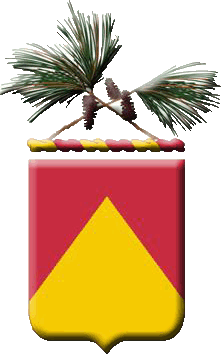
36th Field Artillery Group 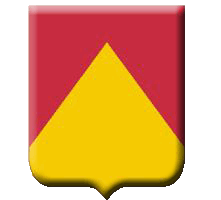 Distinctive Unit Insignia Description A Gold color metal and enamel device 1 3/16 inches (3.02 cm) in height consisting of a shield blazoned: Per chevron Gules and Or. Symbolism The “per chevron” division of the shield signifies that the organization has been placed on the active list twice. Background The distinctive unit insignia was originally approved for the 36th Field Artillery on 10 September 1934. It was redesignated for the 36th Field Artillery Battalion on 27 November 1944. The insignia was redesignated for the 36th Artillery Regiment on 21 November 1958. It was redesignated for the 36th Field Artillery Regiment on 1 September 1971.  Coat Of Arms Blazon Shield Per chevron Gules and Or. Crest On a wreath of the colors Or and Gules, two sprays of long leaf Southern pine in saltire Proper. Motto IN ORDER. Symbolism Shield The “per chevron” division of the shield signifies that the organization has been placed on the active list twice. Crest The crest of long leaf pine denotes the allocation of the regiment. Background The coat of arms was originally approved for the 36th Field Artillery on 10 September 1934. It was redesignated for the 36th Field Artillery Battalion on 27 November 1944. The insignia was redesignated for the 36th Artillery Regiment on 21 November 1958. It was redesignated for the 36th Field Artillery Regiment on 1 September 1971. |
____________________________
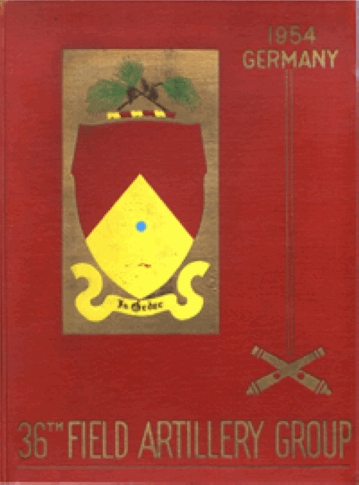
The 36th FA Yearbook of 1954
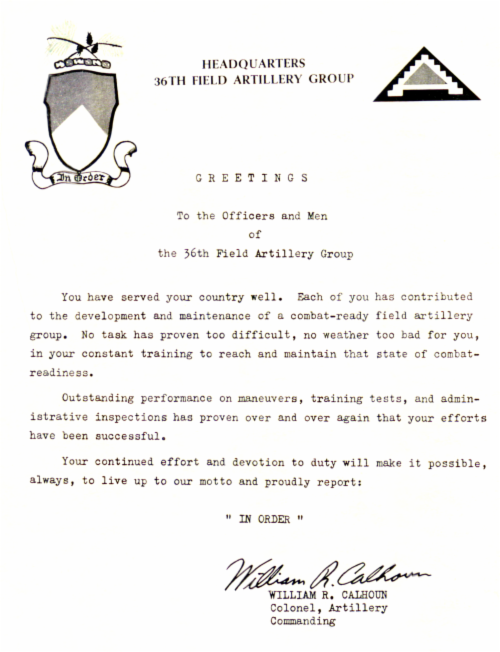
1954
36th Field Artillery Group (original writing from 1952-53) _________________________  Reactivation in Germany As a result of a Department of the Army action taken on 6 February 1951, implemented by Seventh Army on 21 March, Headquarters and Headquarters Battery, 36th Field Artillery Group, was reactivated on 1 April 1951 at Sonthofen, Germany. Col Paul R. Weyrauch, commander of the concurrently disbanded 7732 Field Artillery Group (US Constabulary), became the new group commander. Personnel for the new group were drawn from the 7732 Group; the 70th, 74th, 517th and 519th Field Artillery Battalions the 2nd Armored Cavalry Regiment; and the 2nd Recoiless Rifle Group. Equipment for the battery was drawn from the disbanded headquarters and headquarters battery and the 2nd Recoiless Rifle Group, with additional supplies from EUCOM stocks. Upon activation, the Group was assigned to Seventh Army and remains so assigned at this writing. Following movement to its present home station at Babenhausen, Germany, on 16 May 1951, the Group was attached to 1st Constabulary Brigade, but was relieved from its attachment on 1 July. It was attached to V Corps on 10 September 1951 and on Corps order was further attached to V Corps Artillery. This attachment is still in effect at this time. Original Battalions Attached As of 1 April 1951, this Group had four battalions attached, with stations in Germany, as follows:
Changes Effective 16 May 1951, the 70th and 74th FA Battalions were relieved from attachment to this headquarters and shortly thereafter, the 443rd Antiaircraft Artillery Battalion (AW)(SP), located at Mainz, was attached to the Group. On 6 August 1951, the 18th Field Artillery Battalion and the 631st Armored Field Artillery Battalion, with stations at Babenhausen and Hammelburg, respectively, came under group attachment, and on 25 November, the Group lost the attached AAA battalion. Additional attachments to this headquarters during 1952 raised to six the total number of battalions attached to the Group. On 12 March 1952, the 597th Armored Field Artillery Battalion, with ultimate home station at Hanau, was attached. At about the same time, the 593rd Field Artillery Battalion, stationed at Nellingen, joined this headquarters. The 593rd moved to its permanent home station at Babenhausen on 30 July, placing three battalions in the same kaserne with Group headquarters. Current Battalions Attached The latest change made was that, effective 23 January 1953, the 631st Armd FA Bn was detached from the 36th Group (it was subsequently attached to the 142nd FA Group) and was replaced by the 594th Field Artillery Battalion, stationed at Sandhofen (Mannheim). As of this writing, therefore, 36th FA Group has the following attached units, with stations as shown:
Commanding Officer Following the departure of Col Paul R. Weyrauch, Lt Col Cornelius A. Murphy assumed temporary command of the Group on 14 April 1952. Seven days later command was assumed by Col Robert N. Tyson who retains command at the present time. Training In training exercises conducted in the US Zone of Germany during the past few years, the 36th Field Artillery Group has acquired am excellent reputation. The high professional standards of training and operation evidenced by the group and its attached units has drawn many favorable comments from Senior Commanders. It appears that the group motto, "In Order" has guided the unit in its actions and that it is the goal of all personnel to maintain all things "in order" at all times. Kaserne By coincidence, the 36th FA Group occupies a kaserne once utilized by a unit of the German Army's 36th Field Artillery Regiment. Actually, Babenhausen Kaserne, home of the 36th, is more than 50 years old and has had a varied role in the history of Germany and Europe. Since its completion in 1901, it has been, progressively, an army hospital, a veterinary hospital, a French military post, a German police unit, civilian living quarters, a riding and driving school, a prisoner of war center and a DP center. Following the designation of this Kaserne as a semi-permanent US military post, complete reconstruction of the buildings and grounds was begun. When the last dependents' housing is completed in January 1955, a total of 264 families, approximately 700 dependents, will be housed in Babenhausen. |
The history of the 36TH FIELD ARTILLERY GROUP 1918-1954 (original writing from the 36th FA Yearbook 1954) ____________________________  "InOrder" is the motto of the 36th Field Artillery Group. "In Order" has been its history, and "In Order" is its goal for the future. Officially, the present military lineage of the 36th Field Artillery Group extends back to the 36th Field Artillery Regiment which was organized in 1918. However, some linear association is thought to exist with a 36th Field Artillery (Regiment) that was active in the Philippine Insurrection at the turn of the century. A blood-stained guidon once belonging to Battery F, 36th Field Artillery, plus other now-destroyed pictorial evidence, gives indication of some relation with this older organization. The 36th Field Artillery Regiment was constituted by the War Department on 5 July 1918 as a National Army Unit assigned to the 12th Division. On 7 August 1918, at Camp McClellan, Alabama, it was officially organized as a 155mm howitzer regiment. The regiment remained at Camp McClellan for the balance of World War I and was demobilized at that station on 8 February 1919. More than ten years later, on 22 July 1929, the War Department reconstituted the 36th Field Artillery Regiment on the inactive list of Regular Army units. For all intents and purposes it remained a fully inactive unit for more than four years. It became partially active on 1 October 1933, when the Second Battalion, Fifth Field Artillery Regiment, was inactivated and its personnel were transferred to the concurrently activated Second Battalion of the 36th Field Artillery. This event took place at Fort Bragg, North Carolina, which was to be the home of the battalion for most of the following decade. Next significant step for the 36th was the choice of coat of arms, approved by the Office of the Quartermaster General on 18 April 1935, and the approval of the motto, "In Order." On 29 September 1939, shortly after the outbreak of World War II in Europe, the War Department decided to expand the existing Second Battalion of the 36th Field Artillery into a full regiment. Accordingly, this decision was implemented on 10 October 1939 when Headquarters and Headquarters Battery, 36th Field Artillery Regiment, was activated at Fort Bragg. By the end of 1939, the Regiment had reached full strength and was composed of a headquarters and headquarters battery and three battalions of two firing batteries each. By mid-summer of 1941, it had become the first U.S. Army field artillery regiment to be equipped with the 155mm gun and had been reorganized into two battalions of three batteries each. On activation the 36th became the gun regiment of the 13th Field Artillery Brigade, then stationed at Fort Bragg. The 13th Field Artillery Brigade was, in turn, the Corps Artillery Brigade for the I Army Corps, the headquarters of which was located at Columbia, South Carolina. Entering the early stages of the Allied offensive against the Axis, the regiment took part in the Tunisian Campaign, following which it saw action with the Seventh United States Army on Sicily. The Regiment was subsequently active in the Naples-Foggia and Rome-Arno Campaigns under the Fifth United States Army in Italy. On 5 March 1944, before the capture of Rome, Headquarters and Headquarters Battery of the 36th were redesignated Headquarters and Headquarters Battery, 36th Field Artillery Group, while the battalions organic to the Regiment were redesignated as separate field artillery battalions. Back under Seventh Army, the Group participated in the assault landings in Southern France, earning an arrowhead for the streamer awarded for that campaign. Swinging into Germany, the Group subsequently was active in the Rhineland and Central Europe Campaigns. For its action in support of the engagements at Belfort and Alsace, Headquarters and Headquarters Battery of the Group received the French Croix de Guerre, with palm. Battle honors were also awarded the Group for the following campaigns: Tunisia, Sicily, Naples-Foggia, Rome-Arno, Southern France, Rhineland, Central Europe. After serving for a short time with the Army of Occupation in Germany, the unit was returned to the United States where it was inactivated at Camp Kilmer, New Jersey, on 1 April 1946. The 36th Field Artillery Group claims another post-war unit as a more immediate parent unit in the group's present active life. This unit was the 7732 Field Artillery Group, a European Command Table of Distribution organization, which was formed at Sonthofen, Germany, on 20 July 1948. Assigned to Headquarters, U.S. Constabulary, this unit was at one time the only field artillery group active in Europe and it remained in existence under Constabulary control and later under Seventh United States Army after the latter's reactivation in November 1950. On 1 April 1951, the unit was disbanded. As a result of a Department of the Army action taken on 6 February 1951, implemented by Seventh Army on 21 March, Headquarters and Headquarters Battery, 36th Field Artillery Group, was reactivated on 1 April 1951 at Sonthofen, Germany. On activation the Group was assigned to Seventh Army and remains so at this time. Following movement to its present home station at Babenhausen, Germany, on 16 May 1951, the Group was attached to First Constabulary Brigade but was relieved from this attachment on 1 July. It was attached to V Corps on 10 September 1951 and on Corps order was further attached to V Corps Artillery. This attachment is still in effect at this time. As of June 1954, the 36th Field Artillery Group has the following attached units, with stations as shown: 18th Field Artillery Battalion Babenhausen 517th Armored Field Artillery Battalion Büdingen 519th Field Artillery Battalion Babenhausen 593rd Field Artillery Battalion Babenhausen 594th Field Artillery Battalion Giessen 597th Armored Field Artillery Battalion Hanau In training exercises conducted in the U.S. Zone of Germany during the past few years, the 36th Field Artillery Group has acquired an excellent reputation. The high professional standards of training and operation evidenced by the group and its attached units has drawn many favorable comments from senior commanders. By coincidence the 36th Field Artillery Group occupies a Kaserne once utilized by a unit of the German Army's 36th Field Artillery Regiment. Actually, Babenhausen Kaserne, home of the 36th, is more than fifty years old and has had a varied role in the history of Germany and Europe. Since its completion in 1901, it has been, progressively, an army hospital, a veterinary hospital, a French military post, a German police unit, civilian living quarters, a riding and driving school, Storm Trooper billets, a remount point, a prisoner of war center and a DP center. Following the designation of this kaserne as a semi-permanent U.S. military post, complete reconstruction of the buildings and grounds was begun. When the last of the dependents' housing is completed in January 1955, a total of 264 families, approximately 700 dependents, will be housed in Babenhausen. Present commanding officer of the 36th is Colonel William R. Calhoun, who assumed command on 20 August 1953. ________________________________________ source: 36th FA GP Yearbook 1954 |
___________________________
source: 36th FA GP Yearbook 1954
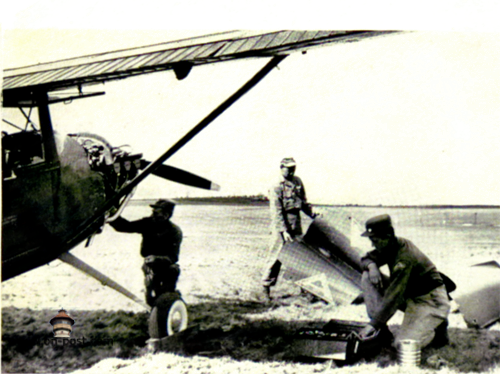
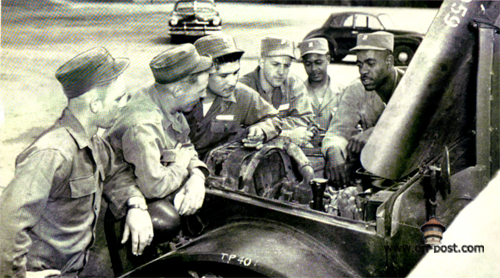
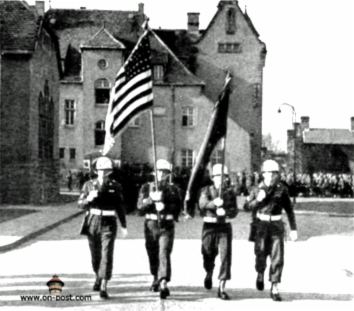
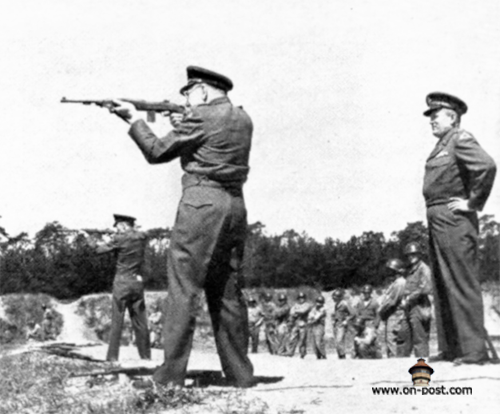
source: 36th FA GP Yearbook 1954
___________________________
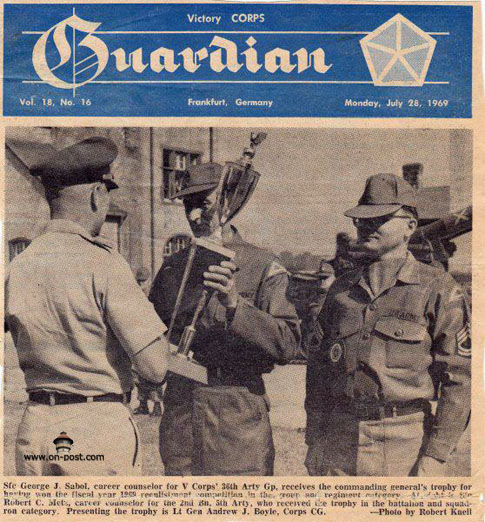
©Maryann Sabol Crowther
___________________________
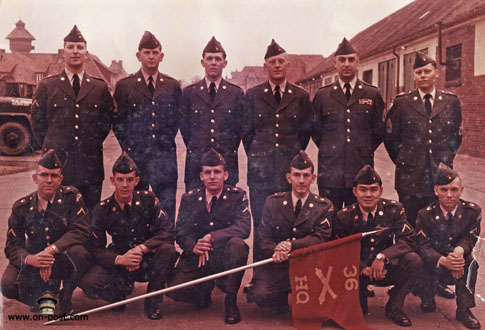
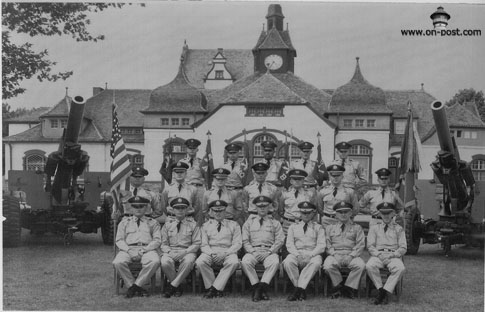
1962
___________________________
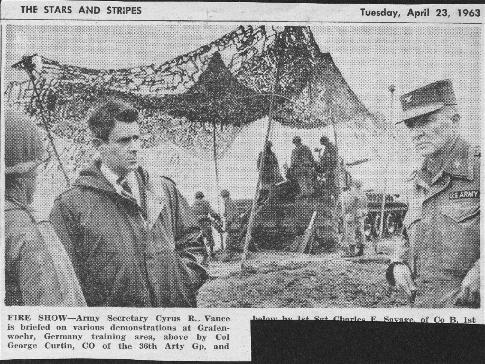
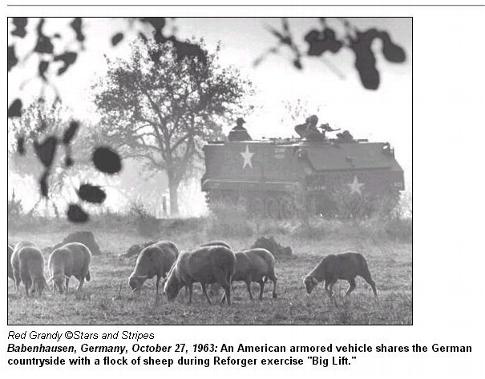
 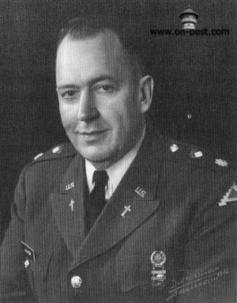 Chaplain MAJ William J. Mayer Also known as "The Bishop of Babenhausen" 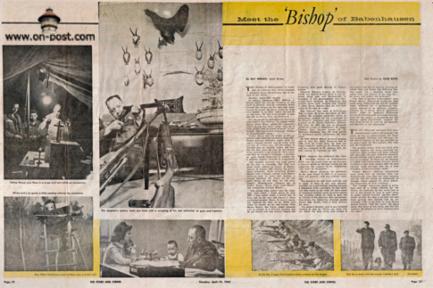 ©1962,2013 Stars and Stripes 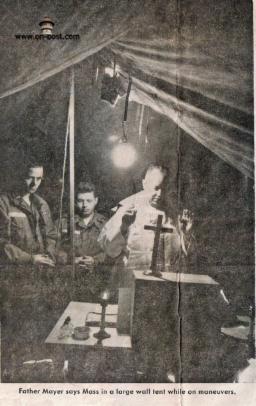 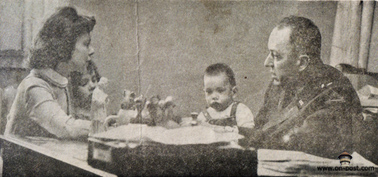 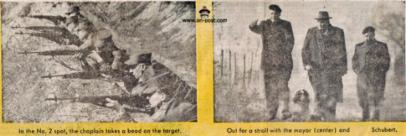 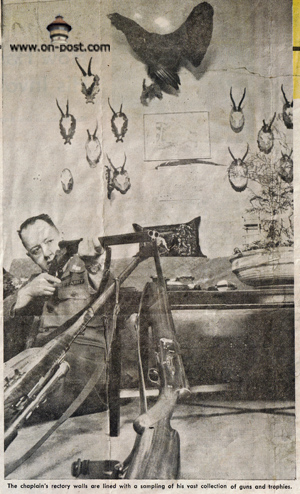 Special thanks to Fred TerryHHB 36th Arty Gp 1962-1965 |
___________________________
All photos © Walt Leon
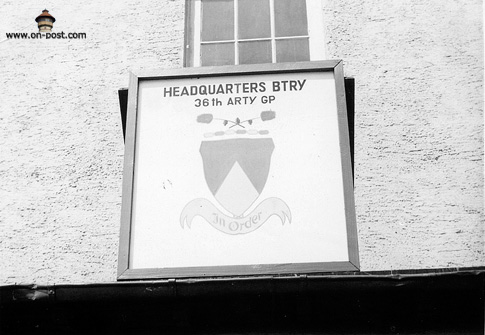
36th Field Artillery HQ
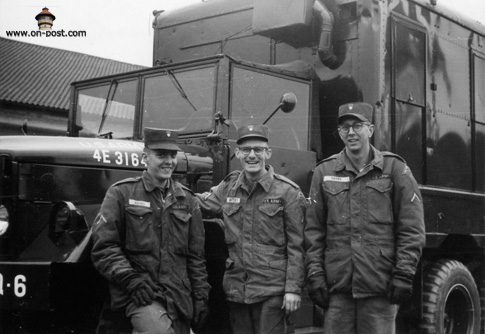
Ron Ashby, Bob Butterly and ? with HQ-6,
the Colonel’s field van.
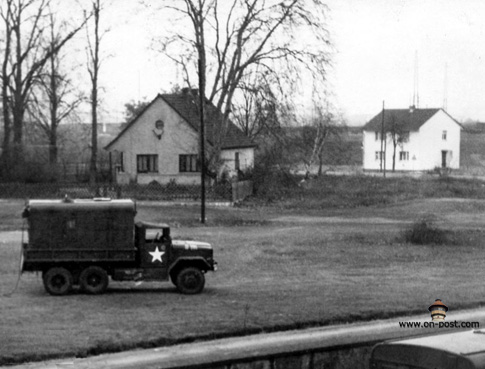
The House on the left side was the Babenhausen Forestry Building, the house on the right was later a Night Club.
___________________________
36th Field Artillery Group 1954  18th Field Artillery Battalion Babenhausen 517th Armored Field Artillery Battalion Büdingen 519th Field Artillery Battalion Babenhausen 593rd Field Artillery Battalion Babenhausen 594th Field Artillery Battalion Giessen 597th Armored Field Artillery Battalion Hanau 465th Field Artillery Battalion Darmstadt 816th Field Artillery Battalion Darmstadt _______________________ 36th Field Artillery Group 1958  1st Msl Bn, 32nd FA (HJ) Hanau 62nd AAA Bn(AW)(SP) Käfertal 216th FA Bn (280mm) Darmstadt 288th AFA Bn (155mm How)(SP) Hanau 531st FA Msl Bn (Cpl) Babenhausen 546th FA Bn (155mm How)(T) Babenhausen 553rd FA Bn (8in How)(T) Darmstadt _______________________ 36th Field Artillery Group 1968  2nd Bn, 5th FA (175mm) Babenhausen 4th Bn, 18th FA (155mm) Hanau 1st Bn, 32nd FA (HJ) Hanau 2nd Bn, 75th FA (8in) Hanau 5th Bn, 77th FA (SGT) Babenhausen 3rd Bn, 80th FA (SGT) Darmstadt B Btry, 1st TA Bn, 26th FA Hanau C Btry, 1st TA Bn, 26th FA Darmstadt On 15 March 1972, the 36th Field Artillery Group was in-activated and was replaced by the 41st Field Artillery Group |
___________________________
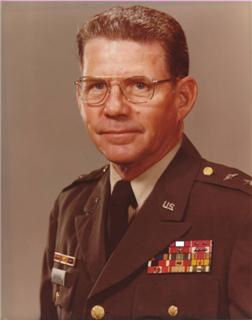
MG Louis W. Prentiss Jr.
519th FA
Battery Officer
1950 - 1952
__________
36th FA GP
Group S-2
1952 - 1953
(click here to read Biography)
To read Chapter Six of "Memories of a Life in the Army" written by
MG Louis W. Prentiss Jr.
Please click here
___________________________
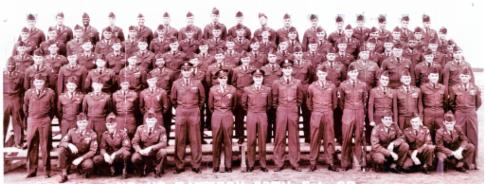
Wayne Dixon ©2010
HQ-HQ Battery
36th Field Artillery Group
Babenhausen
___________________________
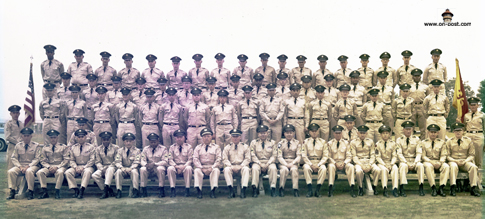
©Fred Terry
Headquarters Battery 36th Field Artillery Group
-August 1964-
Click here to SUPERSIZE
___________________________
-August 1964-
Click here to SUPERSIZE
___________________________
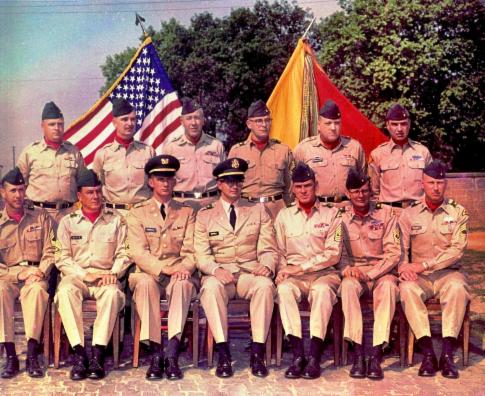
©Albert E Hunter
| 36th Field Artillery Group  The Field Grade Officers  -1964- (Click on the Name to see Picture) COL Albert E. Hunter Gp Commander MAJ Joe R. McCray Group S-1 Officer MAJ Francis R. Cipolla Group S-3 Officer CPT Don L. Walton Group S-2 Officer CPT Stanley W. Brooks Group S-4 Officer Lt William L. MacMurdy Jr. Asst. S-2 Officer CPT Lewis E. Vermillion Asst. S-3 Officer CPT Bernard D. Campbell Hq Btry Co CPT Eddie D. Monroe Aviation Officer CPT Franklin D. Scott RW Aviator CPT Henry D. C. Fuller RW Aviator CW2 Alfred R. Hughes Personnel Officer CW2 Kitt C. Roberts Jr. Motor Officer CPT Maurice H. Schrepel Club Custodian CPT Sollen C. Wilson Jr. Group Commo Officer CPT Julian J. Bundy Ln Officer CW4 Edward H. Cullenbeine Ln Officer CPT George Rowen G-1 V Corps |
___________________________
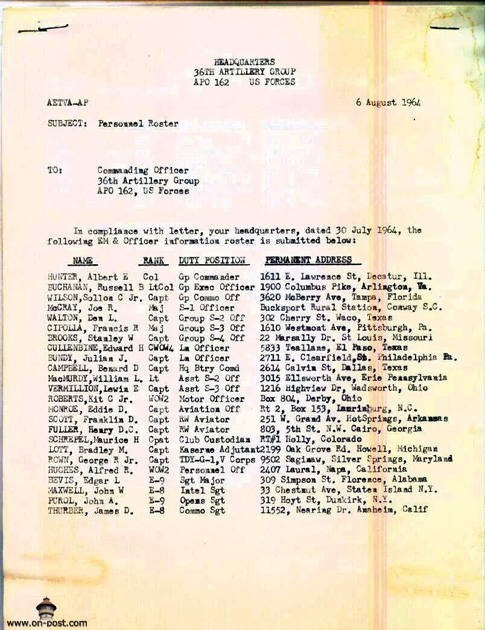
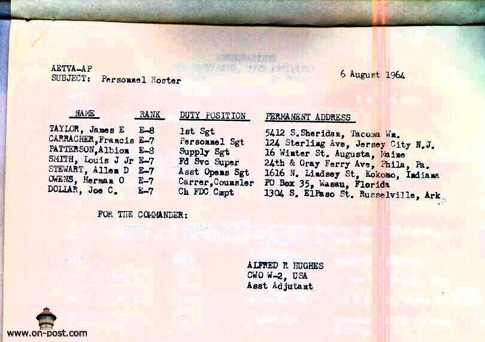
___________________________
36th Field Artillery Group   The Non Commissioned Officers -1964- (Click on the Name to see Picture) SMJ Edgar Bevis 1SG James E. Taylor (HHB) MSG Albion Patterson MSG James D. Thurber (NCO Commo) MSG John A. Purol (NCO S-3) MSG John W. Maxwell (NCO S-2) MSG Louis J. Smith JR. (NCO Food Service) SFC Allen D. Stewart (NCO Asst S3) SFC Bell (36th Arty) SFC Francis Carracher (NCO Personel) SFC Herman O. Owens (NCO Carrier Counsler) SFC Joe C. Dollar (NCO FDC) |
___________________________
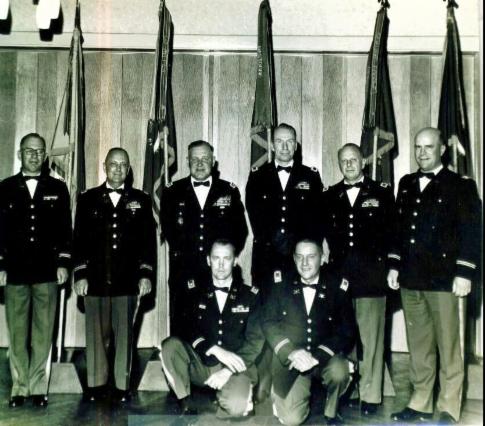
Dining In Ceremony
front row L to R:
MJR Morrison, LTC Buchanan
rear row L to R:
LTC Sandrock, Col Machette, LTG C.Abrams, BG, Norris, COL.Hunter, LTC Lewis
June, 1964
_____________________________________________________________________________________________________________________
Graphics, Articles and photos on this web site are posted by permission of their owners and are for viewing only. They are not for general distribution, nor for use on other websites, unless permitted by the web master or the original owner. If you find any files on this site that you believe are unauthorized, please contact the web master immediately so that the issue can be resolved.
___________________________________________________